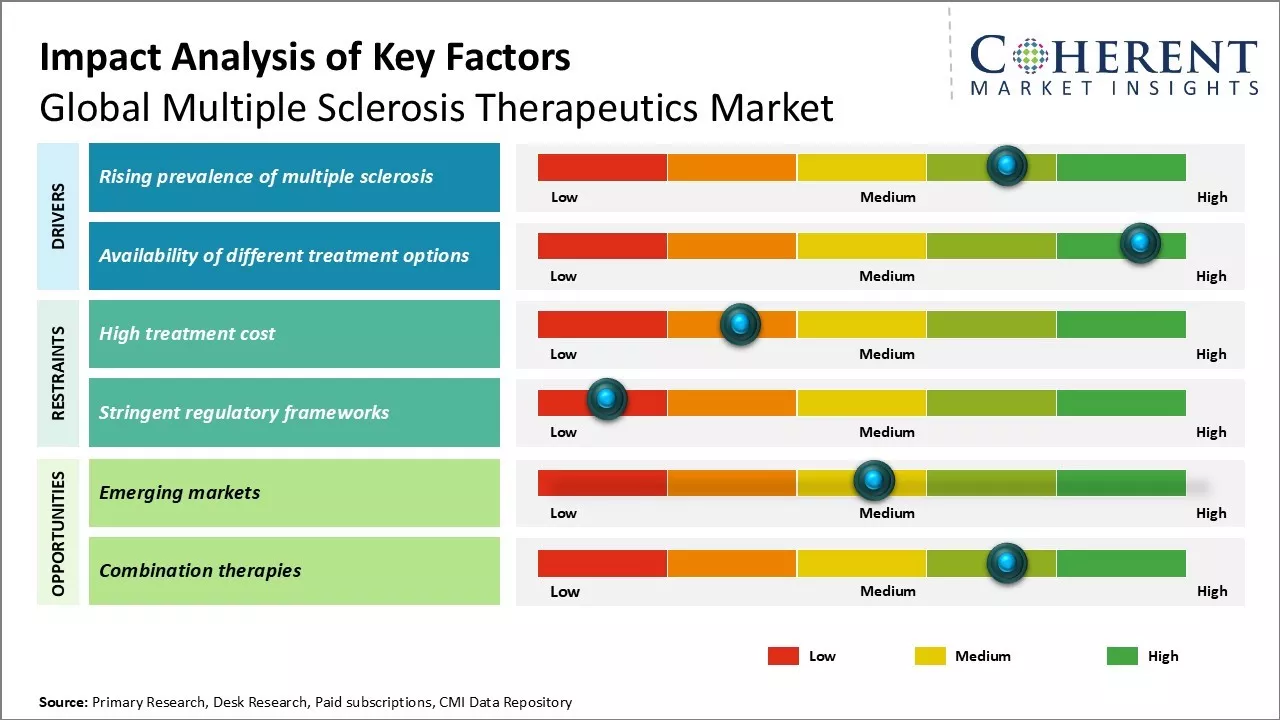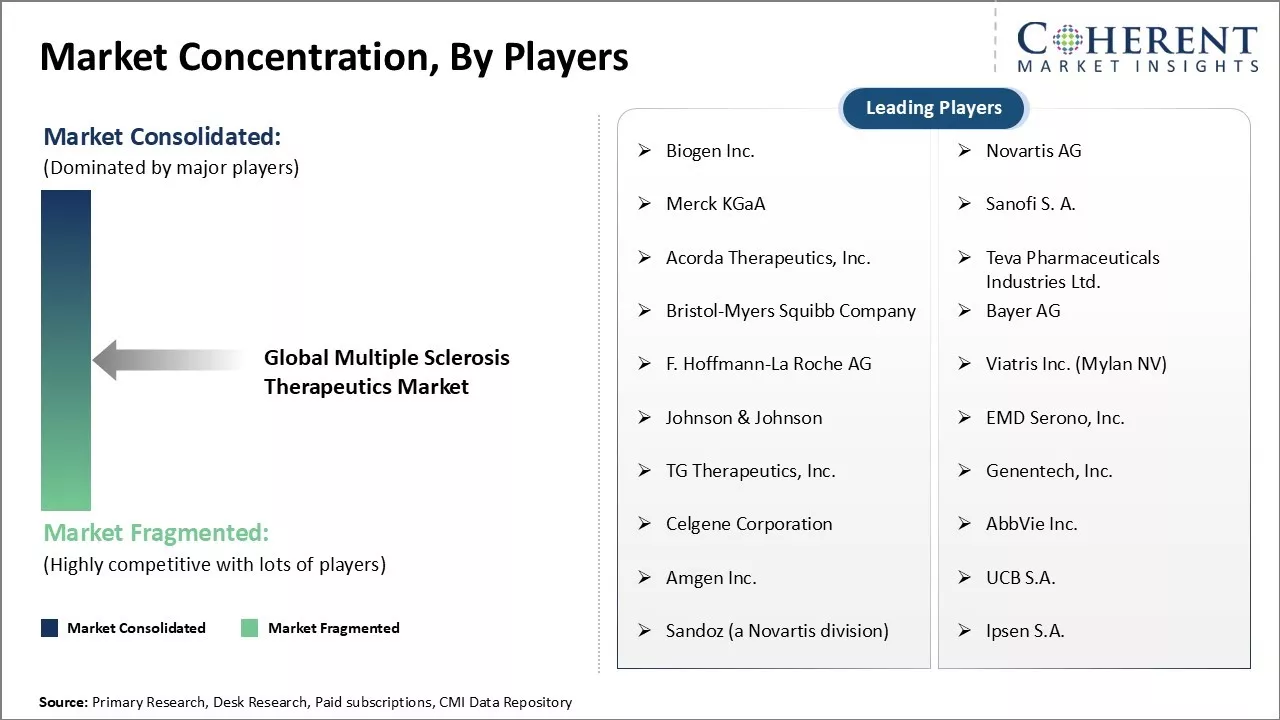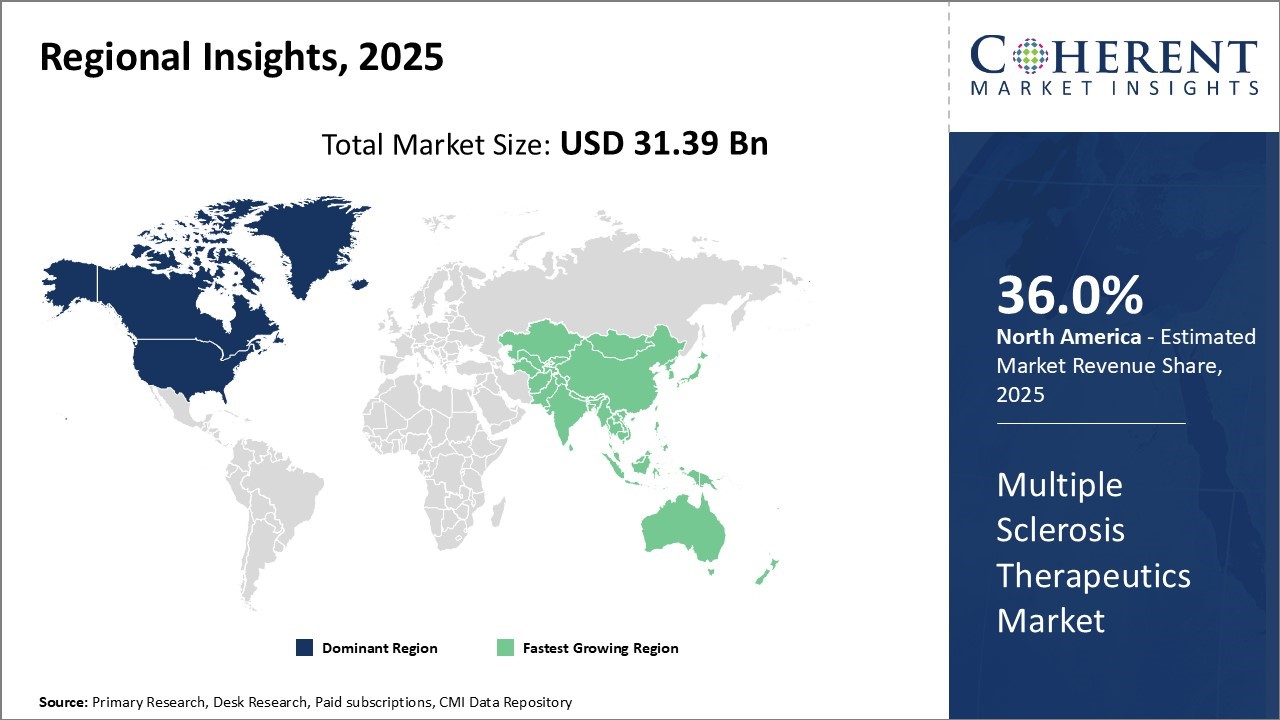The multiple sclerosis therapeutics market is estimated to be valued at USD 31.39 Bn in 2025 and is expected to reach USD 41.89 Bn by 2032, exhibiting a compound annual growth rate (CAGR) of 4.2% from 2025 to 2032.

To learn more about this report, Download Free Sample
The multiple sclerosis therapeutics market encompasses a wide range of treatments aimed at managing and modifying the course of multiple sclerosis, a chronic autoimmune disease affecting the central nervous system. The market includes disease-modifying therapies (DMTs), symptomatic treatments, and emerging cell and gene therapies, all aimed at reducing relapse rates, slowing disease progression, and improving quality of life.
However, a primary restraint in the multiple sclerosis therapeutics market is the high cost of treatment, particularly for disease-modifying therapies (DMTs). These costs place a significant financial burden on patients and healthcare systems, especially in regions with limited insurance coverage or underfunded public health programs.

To learn more about this report, Download Free Sample
|
Current Events |
Description and its impact |
|
Global Regulatory Shifts |
|
|
Technological & Economic Pressures |
|
Uncover macros and micros vetted on 75+ parameters: Get instant access to report
The increasing global prevalence of multiple sclerosis (MS) is a significant driver for the multiple sclerosis therapeutics market, expanding the patient population requiring long-term treatment and accelerating therapeutic innovation.
According to the World Health Organization’s fact sheet on multiple sclerosis published on 7 August 2023, it is estimated that over 1.8 million people worldwide are living with MS.
In terms of drug class, the beta interferon segment is estimated to contribute the highest market share of 40.5% in 2025, owing to its history in clinical use and proven effectiveness.
Beta interferon was one of the first treatments approved for relapsing forms of multiple sclerosis in the 1990s, providing it nearly 30 years of clinical data supporting its efficacy and safety profile. Long-term follow up studies have demonstrated beta interferon's ability to reduce relapse rates, delay disability progression, and mitigate lesions and atrophy in MRI scans compared to untreated patients.
In terms of route of administration, the oral segment is estimated to contribute the highest market share of 48.7% in 2025, due to the clear convenience it offers over injections.
Multiple sclerosis is a chronic condition that requires lifelong management, making the prospect of regular injection-based therapies understandably unappealing for many people. The ability to take a simple pill provides patients a discretion and ease of use that aligns better with their daily lives and sense of normalcy outside of disease treatments.
In terms of distribution channel, hospital pharmacies segment is estimated to contribute the highest market share of 52.5% in 2025, owing to their expansive resources and specialized services.
As medical hubs with neurology departments, hospitals are uniquely positioned to support multiple sclerosis patients. Hospital pharmacies leverage connections to multiple sclerosis treatment teams to coordinate complex medication regimens, providing patients convenient one-stop-shop access to specialty drugs alongside medical guidance.
Artificial Intelligence (AI) is rapidly transforming the landscape of healthcare, and the multiple sclerosis therapeutics market is no exception. By integrating AI-driven technologies, companies are enhancing drug development, personalized treatment, and patient monitoring.

To learn more about this report, Download Free Sample
North America dominates the multiple sclerosis therapeutics market with an estimated market share of 36.0% in 2025. The U.S. accounts for the major share, due to high healthcare expenditures and early availability of new drugs in the country. Several leading biopharmaceutical companies have strategically located their research centers in the U.S. to benefit from the large patient pool and streamlined clinical trial process.
For instance, according to a report by HCAH, in June 2025, Multiple Sclerosis (MS) remains one of the most common causes of neurological disability in young adults. As of 2025, over one million people in the U.S. alone are living with MS.
Asia Pacific is identified as the fastest growing regional market for multiple sclerosis therapeutics in the coming years. Rising incidence of multiple sclerosis cases combined with improving access to healthcare infrastructure and services in countries like China, Japan, and India is boosting the demand for therapeutics. Local pharmaceutical companies have ramped up their capabilities to cater to the domestic requirements with affordable generic drugs.
According to WHO’s Atlas of MS (2020), multiple sclerosis remains relatively uncommon across Southeast Asia, with prevalence typically estimated at around 2–3 per 100,000 population. In China, the Global Burden of Disease study (2019) reports an age‑standardized prevalence of approximately 2.32 per 100,000. Evidence from Korea shows similar figures (~3.2–3.6 per 100,000), while Japan has exhibited a notably higher prevalence, rising to about 23 per 100,000 by 2021. Female predominance is consistently observed, especially in Southeast Asia.
Japan holds a unique position as the second largest pharmaceutical market in Asia, due to its high medical costs and universal healthcare coverage. Majority of new multiple sclerosis drugs in the international markets are quickly made available in Japan with the support of National Health Insurance program.
In Japan, compared to Western countries, the prevalence of MS is significantly lower, and the current estimated prevalence is 10/100,000. The advent of disease-modifying drugs (DMDs) has made it possible to prevent relapse and suppress the progression of physical disabilities.
The U.S. drives a significant portion of the global multiple sclerosis therapeutics market, fueled by high disease prevalence, strong healthcare infrastructure, and substantial investment in R&D. The presence of major pharmaceutical players and a favorable reimbursement environment contribute to rapid adoption of novel therapies, including high-efficacy monoclonal antibodies and oral DMTs.
Germany is a key driver in the Europe multiple sclerosis therapeutics market, due to its well-established universal healthcare system and emphasis on early diagnosis and continuous disease management. Government-supported initiatives for MS research, coupled with the availability of both branded and biosimilar drugs, have increased treatment accessibility. Germany also serves as a strategic hub for clinical trials, particularly for progressive MS, making it attractive for pharmaceutical innovation and partnerships.
Brazil is emerging as a key driver in the Latin America multiple sclerosis market, due to government-funded healthcare programs that provide access to high-cost therapies. The Unified Health System (SUS) includes MS treatments in its formulary, which has helped expand treatment coverage. Furthermore, the country has seen a rise in neurological centers of excellence and public-private partnerships aimed at increasing access to DMTs, especially in urban regions, supporting long-term market growth.
| Report Coverage | Details | ||
|---|---|---|---|
| Base Year: | 2024 | Market Size in 2025: | USD 31.39 Bn |
| Historical Data for: | 2020 To 2024 | Forecast Period: | 2025 To 2032 |
| Forecast Period 2025 to 2032 CAGR: | 4.2% | 2032 Value Projection: | USD 41.89 Bn |
| Geographies covered: |
|
||
| Segments covered: |
|
||
| Companies covered: |
Biogen Inc., Novartis AG, Merck KGaA, Sanofi S. A., Acorda Therapeutics, Inc., Teva Pharmaceuticals Industries Ltd., Bristol-Myers Squibb Company, Bayer AG, F. Hoffmann-La Roche AG, Viatris Inc. (Mylan NV), Johnson & Johnson, EMD Serono, Inc., TG Therapeutics, Inc., Genentech, Inc., Celgene Corporation, AbbVie Inc., Amgen Inc., UCB S.A., Sandoz (a Novartis division), and Ipsen S.A. |
||
| Growth Drivers: |
|
||
| Restraints & Challenges: |
|
||
Uncover macros and micros vetted on 75+ parameters: Get instant access to report
*Definition: Global multiple sclerosis therapeutics market focuses on treating multiple sclerosis (MS), a demyelinating disease in which the insulating covers of nerve cells in the brain and spinal cord are damaged. This market includes drugs for relapsing-remitting MS, primary progressive MS, and secondary progressive MS such as immunomodulators, immunotherapy, corticosteroids, and others. The goal of treatments is to reduce frequency of relapses and slow progression of disability.
Share
Share
About Author
Ghanshyam Shrivastava - With over 20 years of experience in the management consulting and research, Ghanshyam Shrivastava serves as a Principal Consultant, bringing extensive expertise in biologics and biosimilars. His primary expertise lies in areas such as market entry and expansion strategy, competitive intelligence, and strategic transformation across diversified portfolio of various drugs used for different therapeutic category and APIs. He excels at identifying key challenges faced by clients and providing robust solutions to enhance their strategic decision-making capabilities. His comprehensive understanding of the market ensures valuable contributions to research reports and business decisions.
Ghanshyam is a sought-after speaker at industry conferences and contributes to various publications on pharma industry.
Missing comfort of reading report in your local language? Find your preferred language :
Transform your Strategy with Exclusive Trending Reports :
Frequently Asked Questions
Joining thousands of companies around the world committed to making the Excellent Business Solutions.
View All Our Clients